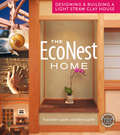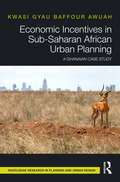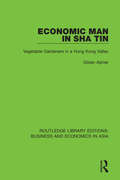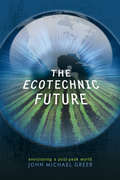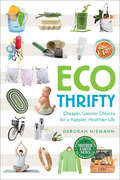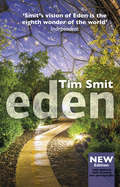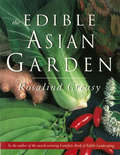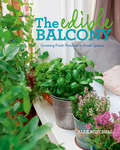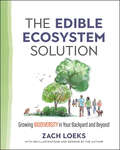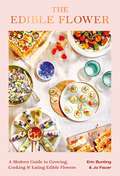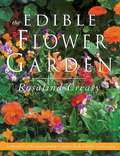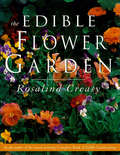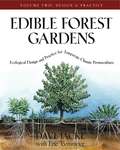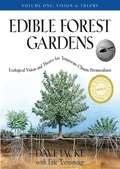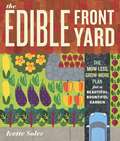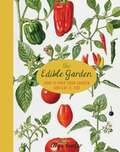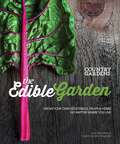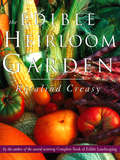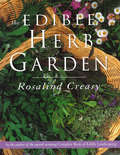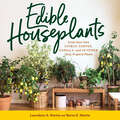- Table View
- List View
The EcoNest Home: Designing & Building a Light Straw Clay House (Mother Earth News Books for Wiser Living)
by Paula Baker-Laporte Robert LaporteAn EcoNest is not just a home—it is a breathtakingly beautiful structure that nurtures health and embraces ecology. This unique approach to construction combines light clay straw, timber framing, earthen floors, natural plasters, and other natural techniques with the principles of Building Biology to create a handcrafted living sanctuary. By bringing together time-honored traditions and modern innovations, owners of EcoNests enjoy living spaces that reflect the best of both worlds. The EcoNest Home is an in-depth exploration of the benefits of choosing this technique over conventional alternatives, combined with a complete practical guide for prospective designers and builders. Paula Baker-Laporte and Robert Laporte draw on their own extensive experience to provide: A detailed explanation of the nature-based science behind EcoNests Fully illustrated, step-by-step instructions to guide you through construction Dozens of inspiring photos of completed projects The most comprehensive North American resource on light clay straw construction, written by its leading proponents, The EcoNest Home is a must-read for anyone considering building their own healthy, affordable, environmentally friendly natural home. Paula Baker-Laporte and Robert Laporte are the creators of the EcoNest concept and the authors of Econest: Creating Sustainable Sanctuaries of Clay, Straw and Timber. Robert has built over fifty houses using the EcoNest system and has trained hundreds of professional builders and aspiring owner-builders in using the techniques. Paula has worked as the architect for the EcoNest Company for nearly two decades and is the author of Prescriptions for a Healthy House.
Economic Incentives in Sub-Saharan African Urban Planning: A Ghanaian Case Study
by Kwasi Gyau Baffour AwuahThis book explores incentives capable of enhancing the effectiveness of urban planning systems in Sub-Saharan Africa using economic theory as a framework. It argues that urban planning is fundamental to the achievement of sustainable and resilient cities, but against the backdrop of rising levels of urbanisation and growth, poverty, informal development, and climate change, such systems are failing to be promoted and successfully maintained in the region. Across ten chapters, it analyses the connection between urban planning and socio-economic development, indicators of effective urban planning systems, and the role and influence of incentives with real-world evidence. It develops quantitative models to estimate the costs and benefits of urban planning systems, focussing on the developing world where organised data is less accessible. Using Ghana as a case study, it demonstrates a step-by-step approach on how to implement the quantitative models discussed. Economic Incentives in Sub-Saharan African Urban Planning will be useful reading for researchers, policy-makers, development agencies, and students in urban planning, sustainable development, and economics.
Economic Man in Sha Tin: Vegetable Gardeners in a Hong Kong Valley (Routledge Library Editions: Business and Economics in Asia #11)
by Göran AijmerThis book, first published in 1980, is a study of how refugee immigrants from China make a living as market gardeners in a valley in Hong Kong. Based on extensive field-work, it examines various aspects of economic life; the discussion concerns the adaptations necessitated on the part of the gardeners by the new socio-economic structures which present themselves. The general problem of agricultural change is discussed and the Hong Kong observations are systematized into a comparative Chinese framework.
The Ecotechnic Future
by John Michael Greer"[John Michael] Greer's work is nothing short of brilliant. He has the multidisciplinary smarts to deeply understand our human dilemma as we stand on the verge of the inevitable collapse of industrialism. And he wields uncommon writing skills, making his diagnosis and prescription entertaining, illuminating, and practically informative. Not to be missed."--Richard Heinberg, Senior Fellow, Post Carbon Institute and author of Peak Everything"There is a great deal of conventional wisdom about our collective ecological crisis out there in books. The enormous virtue of John Michael Greer's work is that his wisdom is never conventional, but profound and imaginative. There's no one who makes me think harder, and The Ecotechnic Future pushes Greer's vision, and our thought processes in important directions." --Sharon Astyk, farmer, blogger, and author of Depletion and Abundance and A Nation of Farmers "In The Ecotechnic Future, John Michael Greer dispels our fantasies of a tidy, controlled transition from industrial society to a post-industrial milieu. The process will be ragged and rugged and will not invariably constitute an evolutionary leap for the human species. It will, however, offer myriad opportunities to create a society that bolsters complex technology which at the same time maintains a sustainable interaction with the ecosystem. Greer brilliantly inspires us to integrate the two in our thinking and to construct local communities which concretely exemplify this comprehensive vision." --Carolyn Baker, author of Sacred Demise: Walking The Spiritual Path of Industrial Civilization's Collapse, and publisher/editor, Speaking Truth to PowerIn response to the coming impact of peak oil, John Michael Greer helps us envision the transition from an industrial society to a sustainable ecotechnic world--not returning to the past, but creating a society that supports relatively advanced technology on a sustainable resource base.Fusing human ecology and history, this book challenges assumptions held by mainstream and alternative thinkers about the evolution of human societies. Human societies, like ecosystems, evolve in complex and unpredictable ways, making it futile to try to impose rigid ideological forms on the patterns of evolutionary change. Instead, social change must explore many pathways over which we have no control. The troubling and exhilarating prospect of an open-ended future, he proposes, requires dissensus--a deliberate acceptance of radical diversity that widens the range of potential approaches to infinity.Written in three parts, the book places the present crisis of the industrial world in its historical and ecological context in part one; part two explores the toolkit for the Ecotechnic Age; and part three opens a door to the complexity of future visions.For anyone concerned about peak oil and the future of industrial society, this book provides a solid analysis of how we got to where we are and offers a practical toolkit to prepare for the future.John Michael Greer is a certified Master Conserver, organic gardener, and scholar of ecological history. He blogs at The Archdruid Report (www.thearchdruidreport.blogspot.com), and is the author ofThe Long Descent.
Ecothrifty: Cheaper, Greener Choices for a Happier, Healthier Life (Mother Earth News Books for Wiser Living)
by Deborah NiemannUse it up, wear it out, make it do, or do without--our grandmothers knew the importance of responsible, thrifty choices. But somewhere along the way we lost our way and succumbed to the belief that we can get everything for next to nothing, have it shipped halfway around the world and then, more often than not, just throw it away. This consumer binge is taking its toll. Diet and lifestyle-related illnesses are epidemic, our environment is awash in a sea of plastic, our climate is changing, and the cost of everything is skyrocketing with the price of oil. Are we doomed? No. We can make greener, healthier choices, and we can do it while saving money. Where to start? Ecofrugal is packed with simple, practical ideas and recipes to help you: Make homemade products for cleaning and skin care Grow your own food and cook more from scratch Raise your family without lowering your standards A must-read for anyone who has ever wanted to live a greener life but thought that it would be too expensive, time-consuming, or difficult, this handy, complete guide will show you how small changes can have a huge environmental impact and save you thousands of dollars, all while improving your quality of life. Deborah Niemann is a homesteader, writer, and self-sufficiency expert. The author of Homegrown and Handmade: A Practical Guide to More Self-Reliant Living, she presents extensively on topics including soapmaking, breadbaking, cheesemaking, composting, and homeschooling.
Eden: Updated 15th Anniversary Edition
by Tim Smit'Smit's vision of Eden is the eighth wonder of the world' Independent'Inspiring... An invaluable guide to how a large project can exceed against all odds' The Sunday Times-An updated edition of the bestselling story of the Eden Project featuring stunning new photography.At the beginning of the twenty-first century, the impossible was delivered. From the sterile depths of a disused china clay pit in Cornwall rose one of the most remarkable and ambitious ventures in recent memory. The Eden Project's Biomes, the world's largest conservatories, are the symbol of a living theatre of plants and people and their interdependence, of regeneration and of a pioneering forum for the exploration of possible futures.This is the extraordinary story of the Eden Project, of its conception, design and construction, of the larger-than-life personalities who made it happen and of all that has happened since its doors were first opened to the public in 2001. It is now undisputedly one of the world's great gardens with more than 17 million visitors flocking there and projects and partnerships all over the world.
The Edible Asian Garden
by Rosalind CreasyMost of us have sampled Asian cuisine at some point in our lives-but what if we could grow pae choi or bamboo shoots in our own garden, and prepare healthy, delicious, and authentic Asian meals right at home? Rosalind Creasy, the doyenne of edible landscaping, has considered the full array of Asian herbs and vegetables and made it possible for the average person to grow and enjoy them right from the backyard. With beautiful photography and region-specific growing tips, Creasy features delicacies from Chinese, Japanese, Indian, and southeast Asian cuisines.With plant information and practical how-to, Creasy takes us on a tour of three of her own successful Asian gardens-one suitable for cool weather, another for warmer weather, and a stir-fry garden-to show the variety of vegetables that can be grown in a range of climates and for a variety of purposes.In "The Asian Garden Encyclopedia," Creasy gives information for 108 distinct varieties of Asian vegetables. Looking for a novel ingredient to add to Friday night stir-fry supper? Why not grow it-the Resources section offers many seed sources for Asian vegetables that are easier to plant than to find at your local market.Finally, in the Recipes section, Creasy presents common Asian ingredients and cooking methods. Enjoy a piping-hot bowl of miso soup as a fortifying breakfast as the Japanese do, or brew some chrysanthemum tea instead. For lunch, sample the classic Indonesian salad called gado-gado;for dinner, try a luscious red Thai curry. In the evening , relax in front of the TV and watch the ball game with beer and fresh-shelled soybeans-considered a popular snack in Asia. Asian cuisine is certainly delicious-and unlike far too many of life's pleasures, it's also good for you.
The Edible Balcony: Growing Fresh Produce in Small Spaces
by Alex MitchellYou don't need a sprawling backyard or spacious raised beds to grow delicious fruits, vegetables, and herbs of your own. In The Edible Balcony, longtime urban gardener Alex Mitchell shows how to transform whatever space you have, from a balcony or rooftop to a fire escape or window box, into a profusion of fresh, seasonal produce.While raising your own produce is eco-friendly in itself, you'll learn how to plant, grow, and water as sustainably as possible to ensure your edible Eden remains green and productive all year long. Plus, with a collection of innovative, step-by-step projects for designing colorful pots and plant supports with recycled containers and other household paraphernalia, you'll double your eco-friendliness, avoid hours of shopping, and be able to infuse your space with your own personal flair and style. Who knew saving time, money, and the environment could be so much fun?A collection of practical advice, fabulous container projects, and stunning examples of how gardeners around the world are successfully transforming urban spaces into abundant fruit and vegetable plots, The Edible Balcony is your guide to creating attractive, responsible, and thoroughly rewarding small space gardens—and perhaps never having to settle for grocery store produce again.
The Edible Ecosystem Solution: Growing Biodiversity in Your Backyard and Beyond
by Zach LoeksStart a peaceful revolution by planting an edible ecosystem and sharing the experience with your neighborsHumans have always thrived in rich, diverse, edible ecosystems. Yet most cities and suburbs are blanketed by lawns, ornamentals, and a lack of biodiversity, let alone anything edible. It is within these sterile landscapes that seeds of an edible ecosystem lie.The Edible Ecosystem Solution is a comprehensive, practical guidebook that looks at underutilized spaces to reveal the many opportunities for landscape transformation that are both far-reaching and immediately beneficial and enjoyable. Contents include:Hundreds of full-color infographics, illustrations, and photographs that clearly outline the principles and concepts of edible landscape design and benefitsHow to get started with as little as 25 square feet of landHow to transition a garden plot into a place of edible abundance and an edible biodiversity hot spot, living laboratory, and a source point for transitioning and transforming community and cultureChoosing appropriate plants for insects, wildlife, and food productionScaling up and networking backyard edible ecosystems at the neighborhood level and beyond to build community food security and resilience.The Edible Ecosystem Solution is for everyone with access to a bit of yard, a desire for food security, biodiversity, and a beautiful and resilient community, and for anyone who wants to reclaim humanity's place in a rich, abundant, edible ecosystem.
The Edible Flower: A Modern Guide to Growing, Cooking and Eating Edible Flowers
by Erin Bunting Jo FacerOn a seven-acre small holding in rural Northern Ireland, organic gardener Jo Facer and head chef Erin Bunting run fork-to-fork supper club, organic small-holding and fledgling cooking and growing school, The Edible Flower. In their first cookbook, learn to grow and cook edible flowers with Jo and Erin's delicious recipes inspired by the seasonal produce they grow in their kitchen garden and the wild food they forage from their local shores and hedgerows. Feast, celebrate and bring people together with over 50 recipes for small plates, mains, desserts, baking, snacks and drinks, at once fresh and flavourful and absolutely stunning to serve. Recipes include: Ribboned Courgette & Avocado Salad with Poppy Seeds & Calendula, Pot Marigold Soda Bread,Lilac Panna Cotta with Strawberries,Rice with Lemon Verbena, Cardamom & Edible Flower Petals,Marigold Petal Pasta,Courgette Flower Tacos,Carnation and Blackberry Cooler,Slow Roast Lamb with Lavender, Lemon & Apricots, Blackberry & Sweet Geranium Tart,Vietnamese Summer Rolls with Violas,Aubergine Katsu Curry with Pickled Magnoliaand many more ...
The Edible Flower Garden
by Rosalind CreasyA comprehensive guide to selecting and growing flowers that can be used for cookery, both as garnishes and as ingredients.
The Edible Flower Garden
by Rosalind CreasyThe Edible Flower Garden is a beautiful collection of flowers that can be used for cookery: from candied violets and roses to decorate appetizers and cakes, to nasturtiums for a colorful shrimp salad, to day lily buds, pink clover, and wild mustard flowers that are tossed together in a spectacular stir-fry.
The Edible Flower Garden
by Rosalind CreasyThe Edible Flower Garden is a beautiful collection of flowers that can be used for cookery: from candied violets and roses to decorate appetizers and cakes, to nasturtiums for a colorful shrimp salad, to day lily buds, pink clover, and wild mustard flowers that are tossed together in a spectacular stir-fry.
The Edible Flower Garden
by Rosalind CreasyLearn how to grow lovely and fragrant flowers then use them create delicious meals with this beautifully illustrated flower gardening and cooking book.Anyone who picks up The Edible Flower Garden will be tempted to grow, harvest, and sample at least a few of the more than forty varieties of edible flowers. Among them you'll find more familiar food plants--dill and mustard, for example--in addition to common flowers, such as tulips or roses. Author Rosalind Creasy's stunning photography and detailed plans for an edible flower garden make this a must-gave book for any flower gardener or home chef.Come along with Creasy on a tour in colorful pictures and careful diagrams and descriptions of her own flower gardens. Included is a tour of the edible flower gardens of Alice Waters famed Chez Panisse restaurant.Creasy catalogues each variety of flower and how to grow it, plus gives a myriad of delectable ideas on how to use the flower from candied violets and roses to decorate appetizers and cakes, to nasturtiums for a colorful shrimp salad, to day lily buds, pink clover and wild mustard flowers that are tossed together in a spectacular stir-fry.
Edible Forest Gardens: Ecological Design And Practice For Temperate Climate Permaculture (Volume #2)
by Dave Jacke Eric ToensmeierIn Volume II, Dave Jacke and Eric Toensmeier move on to practical considerations: concrete ways to design, establish, and maintain your own forest garden. Along the way they present case studies and examples, as well as tables, illustrations, and a uniquely valuable "plant matrix" that lists hundreds of the best edible and useful species.
Edible Forest Gardens: Ecological Vision And Theory For Temperate Climate Permaculture Volume 1
by Dave Jacke Eric ToensmeierEdible Forest Gardens is a groundbreaking two-volume work that spells out and explores the key concepts of forest ecology and applies them to the needs of natural gardeners in temperate climates. Volume I lays out the vision of the forest garden and explains the basic ecological principles that make it work.
The Edible Front Yard: The Mow-Less, Grow-More Plan for a Beautiful, Bountiful Garden
by Ivette Soler“Front lawns, beware: The Germinatrix has you in her crosshairs! Ivette Soler is a welcome voice urging us to mow less and grow some food—in her uniquely fun, infectious yet informative way.” —Garden RantPeople everywhere are turning patches of soil into bountiful vegetable gardens, and each spring a new crop of beginners pick up trowels and plant seeds for the first time. They're planting tomatoes in raised beds, runner beans in small plots, and strawberries in containers. But there is one place that has, until now, been woefully neglected—the front yard. And there's good reason. The typical veggie garden, with its raised beds and plots, is not the most attractive type of garden, and favorite edible plants like tomatoes and cucumbers have a tendency to look a scraggily, even in their prime. But The Edible Front Yard isn't about the typical veggie garden, and author Ivette Soler is passionate about putting edibles up front and creating edible gardens with curb appeal. Soler offers step-by-step instructions for converting all or part of a lawn into an edible paradise; specific guidelines for selecting and planting the most attractive edible plants; and design advice and plans for the best placement and for combining edibles with ornamentals in pleasing ways. Inspiring and accessible, The Edible Front Yard is a one-stop resource for a front-and-center edible garden that is both beautiful and bountiful year-round.
The Edible Garden: How to Have Your Garden and Eat It, Too
by Alys FowlerIn this timely new book, BBC star and Gardening World's thrifty and resourceful Alys Fowler shows that there is a way to take the good life and re-fashion it to fit in with life in the city. Abandoning the limitations of traditional gardening methods, she has created a beautifully productive garden where tomatoes sit happily next to roses, carrots are woven between the lavenders and potatoes grow in pots on the patio. And all of this is produced in a way that mimics natural systems, producing delicious homegrown food for her table. And she shares her favorite recipes for the hearty dishes, pickles and jams she makes to use up her bountiful harvest, proving that no-one need go hungry on her grow-your-own regime. Good for the pocket, good for the environment and hugely rewarding for the soul, The Edible Garden urges urbanites everywhere to chuck out the old gardening rules and create their own haven that's as good to look at as it is to eat.
The Edible Garden
by Alys FowlerIn this timely new book, BBC star and Gardening World's thrifty and resourceful Alys Fowler shows that there is a way to take the good life and re-fashion it to fit in with life in the city. Abandoning the limitations of traditional gardening methods, she has created a beautifully productive garden where tomatoes sit happily next to roses, carrots are woven between the lavenders and potatoes grow in pots on the patio. And all of this is produced in a way that mimics natural systems, producing delicious homegrown food for her table. And she shares her favorite recipes for the hearty dishes, pickles and jams she makes to use up her bountiful harvest, proving that no-one need go hungry on her grow-your-own regime.Good for the pocket, good for the environment and hugely rewarding for the soul, The Edible Garden urges urbanites everywhere to chuck out the old gardening rules and create their own haven that's as good to look at as it is to eat.
The Edible Garden: Grow Your Own Vegetables, Fruits & Herbs No Matter Where You Live
by The Editors of Country Gardens MagazineA seasonal guide to crops with descriptions of varieties for each, including when and how to plant. All the basics you need to start, from tools and containers to seeds and soil. Simple recipes that show how to use your crop yield—and what to do when your garden produces more than you ever expected! Covers a wide range of topics, including: Starting from Seed: Save money by growing from seeds—including those you save yourself from your everyday meals. Making the Plan: How to assess the space at hand and plan to use it most efficiently, including seasonal tips for various environments. Organic Solutions: Raise the healthiest food and protect the environment with these handy hints, including all-natural, chemical-free pest repellants, weed control, and soil enrichment. Container Gardening: Grow food for your table on a balcony, patio, or other small space. Special tips on how to grow some basics even if you&’ve only got a window box to work with. Raised-Bed Gardens: All the rage in suburban front and back yards, rooftops, and community gardens, this results-intensive gardening method yields amazing harvests. Yard-to-Table: Recipes for your backyard bounty focusing on just-picked delights such as fresh tomato and arugula salad, crispy zucchini fritter, and cool cucumber sangria.
The Edible Heirloom Garden
by Rosalind CreasyRosalind Creasy invites gardeners into the colorful and diverse world of heirloom vegetables. Plant, grow, and harvest the vegetables of a century ago, and serve them up using some of the delightful traditional recipes (with modern twists) in this sumptuous book.Replete with photographs of tomatoes, squash, carrots, beans, cabbages and many more, reminiscent of an old-time county fair, Creasy takes you on a tour of heirloom gardens from New England to Idaho and back to the Iowa heartland, where, Kent Whealy points out, many heirloom vegetables are native. In "How To Grow an Heirloom Garden," Creasy gives extensive instructions on saving and storing seeds from year to year. The "Resources" section of the book lists numerous sources for heirloom seeds.The "Encyclopedia of Heirloom Vegetables" section offers beets in white, deep red, and purple, as well as potatoes and tomatoes of every hue and shape. No list of heirloom vegetables would be complete without a section on parsnips, rutabaga, and turnips-the root vegetables that got our forebears through many a long winter.Creasy provides recipes for every season, including "Roasted Parsnips," which can be made fresh from the garden even in winter. Begin a meal with hearty "Beerocks" and end with mouth-watering "Carrot Pie," which, as Creasy points out, wouldn't have been considered dessert at all in Colonial days.
The Edible Herb Garden
by Rosalind CreasyNow from the doyenne of edible landscaping comes a comprehensive and accessible guide to cultivating and cooking herbs.If you have only one book on growing, harvesting and cooking with herbs, this should be it. Creasy takes you from seeds to stove top, from preparing soil to elegant dining, with easy-to-follow instructions and inspirational, imaginative ideas for every step of the way, with a complete "Resources" section.There's information on how to design and grow an herb garden just about anywhere - from a spacious country plot to a small city balcony, from California to Maine and anywhere in between.
The Edible Herb Garden
by Rosalind CreasyNow from the doyenne of edible landscaping comes a comprehensive and accessible guide to cultivating and cooking herbs.If you have only one book on growing, harvesting and cooking with herbs, this should be it. Creasy takes you from seeds to stove top, from preparing soil to elegant dining, with easy-to-follow instructions and inspirational, imaginative ideas for every step of the way, with a complete "Resources" section.There's information on how to design and grow an herb garden just about anywhere - from a spacious country plot to a small city balcony, from California to Maine and anywhere in between.
The Edible Herb Garden
by Rosalind CreasyLearn how to grow hardy and fragrant herbs then use them create delicious meals with this beautifully illustrated herb gardening and cooking book. Author Rosalind Creasy takes you from seeds to stove top, from preparing soil to elegant dining, with easy-to-follow instructions and inspirational, imaginative ideas for every step of the way, with a complete "Resources" section. There's information on how to design and grow an herb garden just about anywhere--from a spacious country plot to a small city balcony, from California to Maine and anywhere in between. With vivid photographs you'll tour various gardens Creasy has created, plus the garden of herb luminary Carole Saville, among others.The comprehensive, fully illustrated "Encyclopedia of Culinary Herbs" section illustrates how to grow and use more than two dozen herb varieties. It includes both old favorites--basil, rosemary, sage, and the like--as well as more exotic herbs from around the world, including salad burnet, lemon verbena, and Mexican tarragon.In the "Favorite Herb Recipes" section you'll find delicious recipes as well as instructions for accompaniments--herb blends and butters, vinegars and teas; main dishes from cuisines around the world; and even cocktails and desserts
Edible Houseplants: Grow Your Own Citrus, Coffee, Vanilla, and 43 Other Tasty Tropical Plants
by Laurelynn G. Martin Byron E. MartinThe world of houseplants just got tastier with this colorful guide to growing edible plants indoors! Houseplant enthusiasts will be delighted to discover the range of tropical plants that can be grown in containers indoors, in any location. Laurelynn and Byron Martin, owners of Logee's Plants for Home & Garden, are nationally renowned for their expertise in growing fruit-bearing and tropical plants indoors. Their colorful guide features photos and complete care guidelines for 46 food-bearing plants, includes lemons, limes, grapefruit, cherries, olives, passion fruit, papaya, and much more. Fresh, fragrant, and flavorful, Edible Houseplants expands the fun and pleasure of growing indoor plants.
